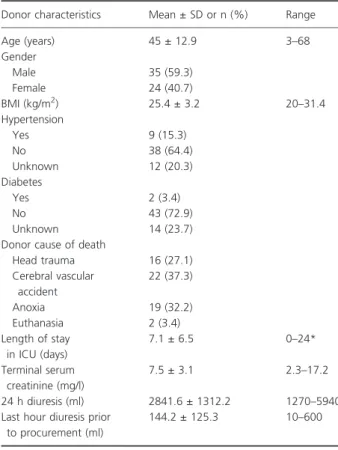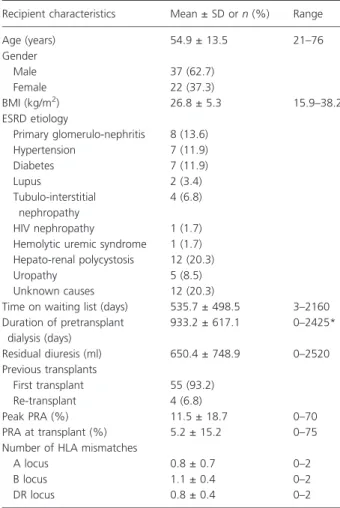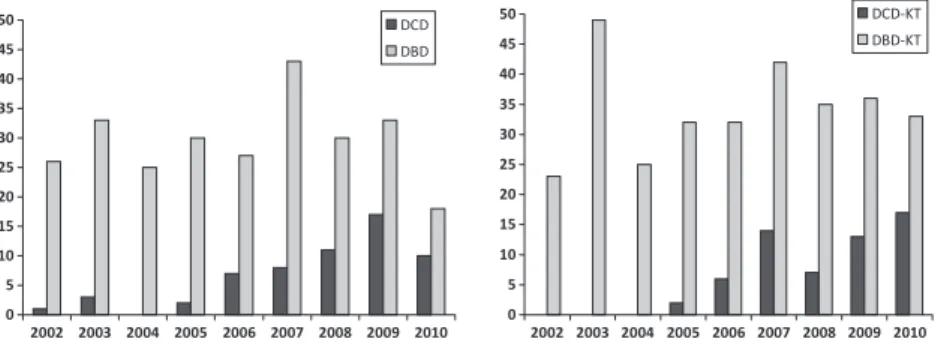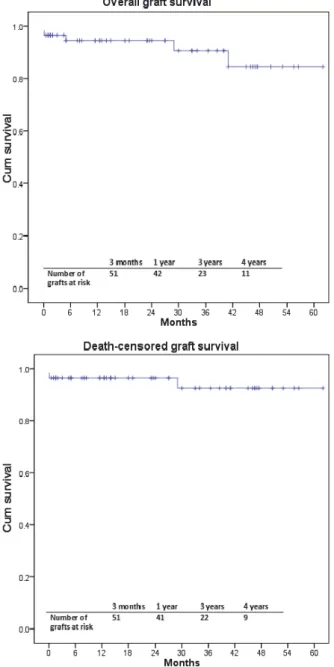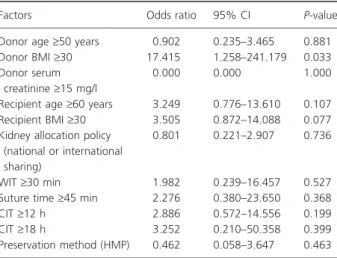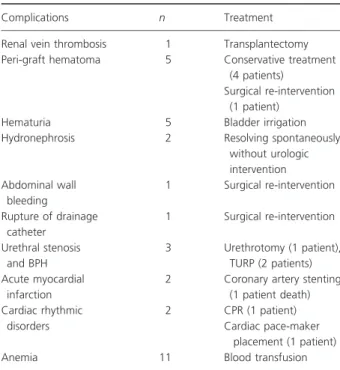O R I G I N A L A R T I C L E
Results of kidney transplantation from controlled donors
after cardio-circulatory death: a single center experience
Hieu Ledinh,1Laurent Weekers,2 Catherine Bonvoisin,2 Jean-Marie Krzesinski,2Jose´e Monard,1 Arnaud de Roover,1Jean Paul Squifflet,1Michel Meurisse1and Olivier Detry11 Department of Abdominal Surgery and Transplantation, University Hospital of Lie`ge, University of Lie`ge, Lie`ge, Belgium 2 Department of Nephrology, University Hospital of Lie`ge, University of Lie`ge, Lie`ge, Belgium
Introduction
Confronted with the universal critical organ shortage, many transplant centers have started the use of donation after cardio-circulatory death (DCD) as an alternative donor source. Results of kidney transplantation (KT) from DCD over the past 30 years showed comparable results with those from donation after brain death (DBD) [1–7]. These results of DCD-KT have led Belgian trans-plant centers to revisit this option and urged the Belgian National Council of Physicians on organ procurement from DCD [8]. The first DCD-KT was performed in Bel-gium in 2000, and up to now all seven Belgian transplant centers have active DCD-KT programs [9,10]. In 2009, there were 60 DCD procurements [21.7% of the deceased donor (DD) pool] and 74 DCD-KT (17.3% of the DD
kidney pool) in comparison with 9 DCD procurements (3.8%) and 14 DCD-KT (3.9%) in 2005. A preliminary report over 44 DCD-KT in Belgium during the 2003– 2005 period showed a delayed graft function (DGF) rate of 20.5% and a primary nonfunction (PNF) rate of 9.1%. DCD kidneys preserved by machine perfusion had a sig-nificant lower rate of DGF than cold-stored kidneys (25% vs. 42%) and the risk of graft loss of 3% [8].
The University Hospital of Lie`ge initiated a program of controlled DCD-KT in 2005 [11]. This study was aimed at evaluating results of DCD-KT at our institute with regard to short- and mid-term graft function, graft and patient survival, rejection and surgical complications. The influence of DGF on graft function and survival as well as the potential DGF risk factors were also analyzed as secondary end-points.
Keywords
brain death, organ preservation, primary graft dysfunction, risk assessment, treatment outcome, warm ischemia.
Correspondence
Hieu Ledinh, Department of Abdominal Surgery and Transplantation, University Hospital of Lie`ge, University of Lie`ge, Sart Tilman B35, 4000 Lie`ge, Belgium. Tel.: +32 4 366 72 16; fax: +32 4 366 70 69; e-mail: ledinhhieu@pnt.edu.vn
Conflicts of Interest
The authors have declared no conflicts of interest.
Received: 25 July 2011
Revision requested: 12 August 2011 Accepted: 14 November 2011 Published online: 23 December 2011 doi:10.1111/j.1432-2277.2011.01402.x
Summary
The aim of this study was to determine results of kidney transplantation (KT) from controlled donation after cardio-circulatory death (DCD). Primary end-points were graft and patient survival, and post-transplant complications. The influence of delayed graft function (DGF) on graft survival and DGF risk fac-tors were analyzed as secondary end-points. This is a retrospective mono-center review of a consecutive series of 59 DCD-KT performed between 2005 and 2010. Overall graft survival was 96.6%, 94.6%, and 90.7% at 3 months, 1 and 3 years, respectively. Main cause of graft loss was patient’s death with a func-tioning graft. No primary nonfunction grafts. Renal graft function was subopti-mal at hospital discharge, but nearly norsubopti-malized at 3 months. DGF was observed in 45.6% of all DCD-KT. DGF significantly increased postoperative length of hospitalization, but had no deleterious impact on graft function or survival. Donor body mass index ‡30 was the only donor factor that was found to significantly increase the risk of DGF (P < 0.05). Despite a higher rate of DGF, controlled DCD-KT offers a valuable contribution to the pool of deceased donor kidney grafts, with comparable mid-term results to those pro-cured after brain death.
Patients and methods
This study is a retrospective review of the experience of the Department of Abdominal Surgery and Transplanta-tion at the University Hospital of Lie`ge with controlled DCD-KT from 2005 to 2010. Kidneys procured from DCD donors were distributed within the Eurotransplant organization according to the same allocation rules as DBD kidneys (except Germany and Croatia where organ procurement and transplantation activity from DCD are prohibited by Law). The rate of local, national, and inter-national sharing was 47.5%, 44.1%, and 8.5%, respec-tively, in this series. The acceptance criteria for DCD kidneys were as follows: donor age less than 65 years; no history of renal disease, uncontrolled hypertension, com-plicated diabetes mellitus, systemic sepsis or malignancy; warm ischemia time (WIT) less than 45 min (from car-dio-circulatory arrest to aortic cold perfusion) or less than 60 min (from withdrawal of life-support to aortic cold perfusion) [12] and terminal serum creatinine <20 mg/l. Donor characteristics are presented in Table 1.
Withdrawal of life support occurred in the operating room. Heparine was injected intravenously prior to
with-drawal of both ventilator and cardiac support in most DCD donors. Vital signs (blood pressure, heart rate, respiratory rate, and trans-cutaneous oxygen saturation) were monitored after discontinuation of treatment until cardio-circulatory arrest took place. Cardio-circulatory arrest was defined by femoral mean arterial pressure less than 30 mmHg without arterial pulse. A 5 min no-touch period was respected after cardio-circulatory arrest, then cardio-circulatory death was declared. Rapid laparotomy with direct aortic cannulation technique was utilized to in situ perfuse organs. HTK was the most common used preservation solution (84.7%) and kidneys were cold-stored in most cases (83.1%). Ten kidney allografts were preserved by the hypothermic machine perfusion (HMP) technique in the context of a Eurotransplant randomized controlled trial about the efficacy of HMP over static cold storage (SCS) [13]. Mean total WIT was 20.1 ± 7.2 min (range: 8–39). This time period comprised the withdrawal phase (from treatment discontinuation to cardio-circula-tory arrest, mean: 9.4 ± 5.5 min, range: 2–30) and the acirculatory phase (from cardio-circulatory arrest to initi-ation of aortic cold perfusion, mean: 10.6 ± 4.8 min, range: 5–27). Mean cold ischemia time (CIT), defined as the time interval from aortic cold perfusion until removal of the kidney graft out of the cold preservation solution for implantation, was 731.3 ± 267.5 min (range: 207– 1255). Mean vascular anastomosis suture time was 35.1 ± 9.7 min (range: 18–60).
Recipient variables are summarized in Table 2. Mean recipient age was 54.9 ± 13.5 years (range: 21–76). Recip-ients older than 65 years received kidneys from older donors in the context of Eurotransplant Senior Program [14]. Mean panel reactive antibodies (PRA) at transplant was 5.2% ± 15.2% (range: 0–75). Mean number of HLA (human leukocyte antigens) mismatches was 2.8 ± 1.0 (range: 0–4). The frequency of 0, 1, 2, 3, and 4 HLA mis-matches was 1.7%, 8.5%, 28.8%, 32.2%, and 28.8%, respectively. Ureteral double J catheter was utilized in half of the patients (49.2%), largely depending on the sur-geon’s preference and experience. All recipients received induction therapy with anti-CD25 monoclonal antibody (basiliximab) and a standard triple therapy with tacroli-mus or cyclosporin, mycophenolate mofetil or mycophen-olic acid and steroids. Anti-infective prophylaxis comprised sulfamethoxazole/trimethoprim for pneumo-cystis and urinary tract infection for at least 6–12 months, valganciclovir for cytomegalovirus (CMV) depending on donor and recipient CMV serologic status (if D+/R): val-ganciclovir for 3 months, other cases: acyclovir for herpes virus for 3 months). Diagnosis of renal allograft rejection was suggested by an unexplained rise in serum creatinine level of >0.3 mg/dl or a 25% increase from baseline level and confirmed by ultrasound-guided per-cutaneous
Table 1. Donor characteristics.
Donor characteristics Mean ± SD or n (%) Range
Age (years) 45 ± 12.9 3–68 Gender Male 35 (59.3) Female 24 (40.7) BMI (kg/m2) 25.4 ± 3.2 20–31.4 Hypertension Yes 9 (15.3) No 38 (64.4) Unknown 12 (20.3) Diabetes Yes 2 (3.4) No 43 (72.9) Unknown 14 (23.7)
Donor cause of death
Head trauma 16 (27.1) Cerebral vascular accident 22 (37.3) Anoxia 19 (32.2) Euthanasia 2 (3.4) Length of stay in ICU (days) 7.1 ± 6.5 0–24* Terminal serum creatinine (mg/l) 7.5 ± 3.1 2.3–17.2 24 h diuresis (ml) 2841.6 ± 1312.2 1270–5940
Last hour diuresis prior to procurement (ml)
144.2 ± 125.3 10–600
*Euthanasia donors did not stay in the ICU. BMI, body mass index; ICU, intensive care unit.
biopsy. Renal biopsy was also routinely done for all grafts at 3 months post-transplant for the purpose of deciding to withdraw steroids or not. Given the importance of subclinical rejection as a risk factor for interstitial fibrosis and tubular atrophy as well as worse glomerular filtration rate (GFR) and graft survival [15], they were all treated with bolus of steroids. Donor specific HLA antibody was checked periodically at the hospital discharge, 3 months and every year post-transplant, simultaneously at the time of graft biopsy and after a sensitizing event. Doppler ultrasound was systemically done at hospital discharge, 3 months and every year post-transplant or at any change of renal allograft function without clear explanation.
The renal transplant was primary transplant in most cases (93.2%) with one combined liver–kidney transplan-tation. There were four re-transplant recipients (6.8%), of whom, one was immunized with peak PRA of 61% while
the remaining three had no panel reactive antibodies. No patients developed donor specific antibodies that were routinely screened by single antigen Luminex technique. The average number of HLA mismatches was 2.2 ± 1.5 (range: 1–4). Cross-match tests were performed at the procurement center with the recipient’s historic sera and repeated again at the transplant center with a recent serum and these tests must be negative prior to graft implantation. For primary transplant recipients who were at low immunological risk, KT was allowed before the result of cross-match test to shorten the CIT.
Primary endpoints of the study were PNF, DGF, graft function at the hospital discharge, 3 months, 1, and 3 years post-transplant, graft and patient survival at 3 months, 1, and 3 years post-transplant. PNF was defined as inadequate renal function after transplantation that necessitates continuation of dialysis, excluding opera-tive technical problems. DGF was defined as the require-ment for haemodialysis during the first week post-transplant, with subsequent recovery of renal function, except dialysis treatments to correct hyper-kalemia or vol-ume overload [16]. Graft function was estimated via serum creatinine and GFR according to the abbreviated Modification of Diet in Renal Disease equation [17,18]. Secondary endpoints of the study were the potential risk factors for DGF, the effect of DGF on graft and patient survival, duration of post-transplant haemodialysis, length of patient’s hospital stay, acute rejection rate within the first 3 months post-transplant and the occurrence of vas-cular or urological complications. Acute rejection was diagnosed on the base of the initiation of anti-rejection treatment or renal biopsy result.
Statistical analysis was as follows: continuous variables were presented as mean ± standard deviation (SD) and categorical variables as percentage. Differences between groups were evaluated by nonparametric Mann–Whitney U/Wilcoxon Ranked Sum tests for continuous variables and Fisher’s exact test or Chi square test for categorical variables. Survival rates were estimated by the Kaplan– Meier method and compared by the log rank test with graft failure and patient death as events. Multivariate logistic regression analysis was used to identify potential risk factors for DGF. All tests were two-tailed and P-val-ues <0.05 were considered as significant. All analyses were performed using the SPSS statistical software, version 11.0 for PC Windows.
Results
During the 6-year period, there were 59 and 215 renal transplants from controlled DCD and DBD donors, respectively. In other words, DCD kidneys made up 21.5% of the DD kidney pool and helped to increase the
Table 2. Recipient characteristics.
Recipient characteristics Mean ± SD or n (%) Range
Age (years) 54.9 ± 13.5 21–76 Gender Male 37 (62.7) Female 22 (37.3) BMI (kg/m2) 26.8 ± 5.3 15.9–38.2 ESRD etiology Primary glomerulo-nephritis 8 (13.6) Hypertension 7 (11.9) Diabetes 7 (11.9) Lupus 2 (3.4) Tubulo-interstitial nephropathy 4 (6.8) HIV nephropathy 1 (1.7)
Hemolytic uremic syndrome 1 (1.7) Hepato-renal polycystosis 12 (20.3)
Uropathy 5 (8.5)
Unknown causes 12 (20.3)
Time on waiting list (days) 535.7 ± 498.5 3–2160 Duration of pretransplant dialysis (days) 933.2 ± 617.1 0–2425* Residual diuresis (ml) 650.4 ± 748.9 0–2520 Previous transplants First transplant 55 (93.2) Re-transplant 4 (6.8) Peak PRA (%) 11.5 ± 18.7 0–70 PRA at transplant (%) 5.2 ± 15.2 0–75
Number of HLA mismatches
A locus 0.8 ± 0.7 0–2
B locus 1.1 ± 0.4 0–2
DR locus 0.8 ± 0.4 0–2
*One pre-emptive kidney transplant in the context of combined liver-kidney transplantation.
BMI, body mass index; ESRD, end-stage renal disease; PRA, panel reactive antibody; HLA, human leukocyte antigens; HIV, human immu-nodeficiency virus.
activity of KT up to 27.4% without impairing the DBD kidney source. The organ procurement and transplanta-tion activity of the KT program at the University Hospital of Lie`ge from 2005 to 2010 is presented in Fig. 1.
Functional and survival data
Analysis of Kaplan–Meier survival curves showed overall and death-censored graft survival rates were 96.6% and 96.6% at 3 months, 94.6% and 96.6% at 1 year, 90.7% and 92.6% at 3 years, and 84.6% and 92.6% at 4 years, respec-tively (Fig. 2). Five renal grafts were lost during the post-transplant follow-up, one because of renal vein thrombosis, one secondary to the relapse of HIV infection in the allo-graft and three others because of patient deaths. Mean follow-up of patients was 26.5 months (range: 0.5– 62 months). Patient survival rates at 3 months, 1, 3, and 4 years were 98.3%, 96.3%, 96.3%, and 90.3%, respectively (Fig. 3). Three patients (5.1%) died during follow-up, one because of acute myocardial infarction 24 h postoperatively and other two because of broncho-pneumonitis caused by CMV and Aspergillus infection at 5 and 41 months.
No PNF grafts were observed in this series. Two recipi-ents were excluded from the analysis of DGF rates, because one died 24 h post-transplant and it remain unknown whether the graft was functioning at the time of patient death, the other lost the kidney graft because of renal vein thrombosis. Twenty-six of 57 patients (45.6%) experienced DGF. The occurrence of DGF did not adversely influence graft survival, as overall graft sur-vival rates were 100%, 95%, 95%, and 83.1% for patients with DGF compared with 100%, 100%, 91.7%, and 91.7% for patients without DGF at 3 months, 1, 3, and 4 years, respectively (P = 0.52, Fig. 4). In addition, DGF did not increase the risk of acute rejection or surgical complications: among 26 recipients with DGF, 8 (30.7%) developed acute rejection compared with 8 (25.8%) recip-ients without DGF (P = 0.67). The rate of all surgical complications was 34.6% and 25.8% in recipients with and without DGF, respectively (P = 0.46).
The use of HMP (n = 10) was associated with a non-statistically significant lower rate of DGF in comparison to that of SCS (30% versus 48.5%, respectively, P = 0.31). Likewise, donor age (‡60 years), donor terminal serum creatinine (‡15 mg/l), recipient age (‡60 years), recipient BMI (BMI ‡ 30), kidney allocation policy (national or international sharing), WIT (‡45 min), suture time (‡45 min) as well as CIT (‡18 h) had no apparent effect on the risk for DGF (P = NS, both in univariate and multivariate logistic regression analysis, Table 3). Donor body mass index (BMI), in contrast, had an impact on DGF in multivariate model (not in univariate analysis). Kidneys from donors with BMI ‡ 30 compared with ones with BMI < 30 was 17 times more likely to have DGF (P = 0.03).
One patient was transplanted because of HIV nephrop-athy and lost quite rapidly her renal allograft (29 months post-transplant) secondary to the relapse of HIV infection in the allograft. This was a rare indication of transplanta-tion and this patient was excluded in the assessment of renal allograft function. Mean serum creatinine level at hospital discharge was 22.1 ± 11.7 mg/l (range: 6.8–56.6). The percentage of patients with serum creatinine level at hospital discharge <20, 20–40, and >40 mg/l was 61.1%, 25.9%, and 13%, respectively. Renal graft function con-tinued to improve up to 3 months post-transplant and nearly stabilized over the following 4 years (Fig. 5). The mean GFR at hospital discharge, 3 months, 1, and 3 years was 37.1 ± 16.6, 50.7 ± 11.7, 50.9 ± 11.3, and 49.2 ± 11.2 ml/min, respectively. Among four recipients who underwent retransplantation, two developed DGF. However, the four kidney grafts functioned well during the study period.
Postoperative evolution and complications
The average number of haemodialysis post-transplant in case of DGF was 4.96 ± 6.01 sessions (range: 1–32). Mean duration of haemodialysis was 10.6 ± 17.1 days (median: 7, range: 1–90). Mean hospital stay was 17.8 ± 5.7 days
0 5 10 15 20 25 30 35 40 45 50 2002 2003 2004 2005 2006 2007 2008 2009 2010 DCD DBD 0 5 10 15 20 25 30 35 40 45 50 2002 2003 2004 2005 2006 2007 2008 2009 2010 DCD-KT DBD-KT
Figure 1 Organ donation and kidney transplantation activity in Lie`ge over time. The number of DCD-KT increased without impairing the number of DBD-KT. DCD: donors after cardiac death. DBD: donors after brain death. KT: kidney transplants.
(range: 2–32). There was a significant difference in length of hospitalization between DGF and IGF (immediate graft function) groups (19.3 ± 5.3 vs. 13.4 ± 3.9 days, P < 0.001).
Sixteen of 59 patients (27.1%) experienced graft rejec-tion during the first 3 months post-transplant, making up 17 rejection episodes. Rejection might be either clinically suspected without graft biopsy (10.1%) or biopsy-proven at the time of rejection suspicion (8.5%) or diagnosed only at 3 month protocol biopsy (8.5%).
Early postoperative complications are presented in Table 4. After hospital discharge, renal artery stenosis was detected in two patients (3.4%) and stenting was neces-sary in one of them. Peripheral artery disease developed in two patients and all of them were stented at the level of iliac arteries. Infectious complications included pulmo-nary tuberculosis (one patient) and uripulmo-nary tract infection (11 patients). Urologic exploration was performed in one patient because of repeated urinary infection, but no uri-nary anomaly was found. Peri-renal lymphocele occurred in one patient and was treated by puncture aspiration technique. One patient became pregnant 20 months post-transplant and gave birth of a healthy boy at 33rd amenorrheal week because of pre-eclampsia. No urinary leakage or ureteral obstruction was observed during the study period.
Discussion
This study showed excellent results of controlled DCD-KT, which were comparable to those from DBD in the literature although the use of DCD kidneys led to an ele-vated rate of DGF because of the unavoidable WIT between the withdrawal of life-support and the initiation of cold preservation. DGF increased significantly the length of hospitalization, nevertheless had no deleterious impact on post-transplant DCD kidney outcomes as dem-onstrated in several other studies [19,20]. A recent meta-analysis in studies with controlled DCD donors showed no difference in PNF rate between two groups of DBD
Figure 2 Overall and death-censored graft survival after DCD-KT (n = 59). Overall and actuarial graft survival rates were 96.6% and 96.6% at 3 months, 94.6% and 96.6% at 1 year, 90.7% and 92.6% at 3 years, and 84.6% and 92.6% at 4 years, respectively.
Figure 3 Overall patient survival after DCD-KT. Patient survival rates at 3 months, 1, 3, and 4 years were 98.3%, 96.3%, 96.3%, and 90.3%, respectively.
and DCD kidneys. The only significant difference was the DGF rate [21]. In our series, we did not experience any PNF and found a DGF rate of 45.6%. However, this high rate of DGF was not associated with an increased graft loss. When evaluating risk factors for DGF, only donor BMI ‡ 30 was significantly associated with an increased rate of DGF in multivariate logistic regression model. The significance of this finding remains unclear.
The DCD kidneys recovered their function slowly and in majority of cases failed to optimize their function at
the time of hospital discharge. However, their function continued to improve and nearly normalized at 3 months post-transplant. Afterward renal allograft function stabi-lized over the following 4 years. By examining outcomes of DCD KTs that functioned for at least 1 year and had a follow-up of 2–5 years, Chapman found that the rate of graft loss at 5 years was similar between DCD and DBD
Figure 4 Graft and patient survival between DGF and no DGF groups. The presence of DGF did not adversely influence graft and patient survival (P = NS).
Table 3. Multivariate logistic regression analysis between the risk of DGF and different factors linked to the donor, recipient or transplan-tation procedure.
Factors Odds ratio 95% CI P-value
Donor age‡50 years 0.902 0.235–3.465 0.881
Donor BMI‡30 17.415 1.258–241.179 0.033
Donor serum creatinine‡15 mg/l
0.000 0.000 1.000
Recipient age‡60 years 3.249 0.776–13.610 0.107
Recipient BMI‡30 3.505 0.872–14.088 0.077
Kidney allocation policy (national or international sharing)
0.801 0.221–2.907 0.736
WIT‡30 min 1.982 0.239–16.457 0.527
Suture time‡45 min 2.276 0.380–23.650 0.368
CIT‡12 h 2.886 0.572–14.556 0.199
CIT‡18 h 3.252 0.210–50.358 0.399
Preservation method (HMP) 0.462 0.058–3.647 0.463 DGF, delayed graft function; BMI, body mass index; WIT, warm ische-mia time; CIT, cold ischeische-mia time; HMP, hypothermic machine perfu-sion.
grafts (approximately 3%) and both groups showed simi-lar declines in GFR after 1 year ()1.3 ml/min for the DCD group vs. )1.4 ml/min for the DBD group). This means that DCD kidneys might have a reduced function-ing glomerular mass because of the initial ischemic dam-age, but once transplanted there was no evidence of accelerate deterioration [22].
Graft survival rates in this study were favorably compa-rable to other reported series [1,4,23,24]. The major cause of graft loss was patient death with a functioning graft. Although DCD kidneys experienced worse early trans-plant outcomes than those coming from DBD donors, they did provide real survival benefit to patients [25]. Patients who were willing to accept a standard-criteria DCD kidney had a 56% reduction in mortality risk com-pared with those remaining on dialysis or awaiting a stan-dard-criteria DBD kidney. This reduction in mortality translates into 2.4 months additional expected lifetime during the first 4 years after transplantation for recipients of DCD kidneys in comparison with patients who wait for a DBD kidney [26].
The rate of clinical and subclinical rejection in our study was similar to that reported in many studies, either single-center reports [4,27,28], national databases [2,29] or a recent meta-analysis [21]. DCD kidneys, despite experiencing greater DGF rates, do not display a greater incidence of acute allograft rejection episodes (10–19%) compared with DBD kidneys (9–18%). Similarly, in a
recent publication, Saeb-Parsy did not find any difference in the rate of major urological complications (urinary leak and ureteral stenosis) between DCD and DBD kidney grafts (3.5% versus 1.7%, P = 0.28) [30]. Inversely, Dro-upy found that the risk of ureteral stenosis and fistula was significantly higher for DCD than DBD kidneys (15% vs. 7%, P = 0.04) [31]. In 76 controlled DCD-KT per-formed at Leiden University Medical Centre, Khairoun reported one urinary leakage because of ureteral necrosis and two ureteral obstructions (one after removal of the double J stent and the other because of blood clot) [32]. The rate of renal artery stenosis in this study was 3.4%. Although the incidence of transplant renal artery stenosis is expected to be higher in DCD kidneys because of the exposure to an excessive ischemic injury, many published series, as ours, also did not find any significant difference between DCD and DBD kidneys [33].
Estimates suggested that the potential increase in the number of DCD kidneys might be 2–4.5 times that of DBD kidneys [34]. However, in practice, single-center reports usually described a 20–40% proportion of DCD KTs among the DD kidney pool [1,24,35,36]. Exception-ally, a few transplant centers have obtained 50–70%, such as in Maastricht [37] or Madrid [38,39]. Recently several transplant centers in the Netherlands [40], the United Kingdom (UK) [41] and the United States (US) [42] have observed a remarkable increase in the number of DCD donors with a concomitant decrease in DBD donors, resulting in no significant change in the DD pool, some kind of redistribution of donor types within the pool. We have not yet observed such a trend in our experience.
No significant difference in the rate of DGF between ice-stored and machine-perfused DCD kidneys was noted in this study, although the DGF rate was lower among machine-perfused grafts. A recent multi-centric random-ized controlled trial, in which 164 DCD kidney pairs were split and one allocated to each preservation modality, convincingly demonstrated that HMP produced less fre-quent and less severe DGF compared with SCS group (54% versus 70%) [13]. In a study design similar to Mo-ers’s study, Watson in the UK found no benefit of HMP over SCS for DCD kidneys. Nevertheless, the author emphasized on the ischemia time as an important factor for the differences between the two trials [43]. A meta-analysis undertaken by Wright [44] and studies in the US using the national database [3,45] all confirmed the advantage of HMP over SCS in DCD kidneys.
Conclusion
The use of controlled DCD kidneys might be an effective way to increase the number of kidneys available for trans-plantation because of good transplant outcomes and
Table 4. Early postoperative complications.
Complications n Treatment
Renal vein thrombosis 1 Transplantectomy
Peri-graft hematoma 5 Conservative treatment
(4 patients)
Surgical re-intervention (1 patient)
Hematuria 5 Bladder irrigation
Hydronephrosis 2 Resolving spontaneously
without urologic intervention Abdominal wall bleeding 1 Surgical re-intervention Rupture of drainage catheter 1 Surgical re-intervention Urethral stenosis and BPH 3 Urethrotomy (1 patient), TURP (2 patients) Acute myocardial infarction
2 Coronary artery stenting (1 patient death) Cardiac rhythmic disorders 2 CPR (1 patient) Cardiac pace-maker placement (1 patient)
Anemia 11 Blood transfusion
BPH, benign prostatic hypertrophy; TURP, trans-urethral resection of prostate; CPR, cardio-pulmonary resuscitation.
acceptable postoperative complications. Despite a higher rate of DGF with longer hospitalization, DGF had no harmful effect on the graft future in this series. By using this donor source, transplant centers could help optimize the quality of life and minimize the mortality of end-stage kidney disease patients on the waiting list.
Authorship
HL: designed the study, collected and analyzed the data and wrote the article. LW, CB, and JMK: were responsible for the selection and follow-up of the patients reported in the study; they analyzed the data and corrected the manu-script. JM: collected the data. ADR, J-PS, MM, and OD: performed the procurements and transplantations reported in the study; they analyzed the data and cor-rected the manuscript. OD: supervised the study.
Funding
No funding was required for this study.
References
1. Akoh JA, Denton MD, Bradshaw SB, Rana TA, Walker MB. Early results of a controlled non-heart-beating kidney donor programme. Nephrol Dial Transplant 2009; 24: 1992.
2. Doshi MD, Hunsicker LG. Short- and long-term outcomes with the use of kidneys and livers donated after cardiac death. Am J Transplant 2007; 7: 122.
3. Locke JE, Segev DL, Warren DS, Dominici F, Simpkins CE, Montgomery RA. Outcomes of kidneys from donors after cardiac death: implications for allocation and preser-vation. Am J Transplant 2007; 7: 1797.
4. Sudhindran S, Pettigrew GJ, Drain A, et al. Outcome of transplantation using kidneys from controlled (Maastricht category 3) non-heart-beating donors. Clin Transplant 2003; 17: 93.
5. Ledinh H, Bonvoisin C, Weekers L, et al. Results of kidney transplantation from donors after cardiac death. Trans-plant Proc 2010; 42: 2407.
6. Moers C, Leuvenink HG, Ploeg RJ. Donation after cardiac death: evaluation of revisiting an important donor source. Nephrol Dial Transplant 2010; 25: 666.
7. Snoeijs MG, Winkens B, Heemskerk MB, et al. Kidney transplantation from donors after cardiac death: a 25-year experience. Transplantation 2010; 90: 1106.
8. Squifflet JP. Why did it take so long to start a non-heart-beating donor program in Belgium? Acta Chir Belg 2006; 106: 485.
9. Van Gelder F, Delbouille MH, Vandervennet M, et al. An 11-Year overview of the Belgian donor and transplant statistics based on a consecutive yearly data follow-up and
comparing two periods: 1997 to 2005 versus 2006 to 2007. Transplant Proc 2009; 41: 569.
10. Van Gelder F, Delbouille MH, Vandervennet M, et al. Overview of the Belgian donor and transplant statistics 2006: results of consecutive yearly data follow-up by the Belgian Section of Transplant Coordinators. Transplant Proc 2007; 39: 2637.
11. Ledinh H, Meurisse N, Delbouille MH, et al. Contribution of donors after cardiac death to the deceased donor pool: 2002 to 2009 University of Liege experience. Transplant Proc 2010; 42: 4369.
12. Bernat JL, D’Alessandro AM, Port FK, et al. Report of a National Conference on Donation after cardiac death. Am J Transplant 2006; 6: 281.
13. Moers C, Smits JM, Maathuis MH, et al. Machine perfu-sion or cold storage in deceased-donor kidney transplanta-tion. N Engl J Med 2009; 360: 7.
14. Smits JM, Persijn GG, Van Houwelingen HC, Claas FH, Frei U. Evaluation of the Eurotransplant Senior Program The results of the first year. Am J Transplant 2002; 2: 664.
15. El-Amm JM, Gruber SA. The significance of subclinical rejection. Clin Transplant 2009; 23: 150.
16. Yarlagadda SG, Coca SG, Garg AX, et al. Marked variation in the definition and diagnosis of delayed graft function: a systematic review. Nephrol Dial Transplant 2008; 23: 2995. 17. Houillier P, Froissart M. Elevated serum creatinine. Rev
Prat 2005; 55: 91.
18. Flamant M, Boulanger H, Azar H, Vrtovsnik F. Plasma creatinine, Cockcroft and MDRD: validity and limitations for evaluation of renal function in chronic kidney disease. Presse Med 2010; 39: 303.
19. Brook NR, White SA, Waller JR, Veitch PS, Nicholson ML. Non-heart beating donor kidneys with delayed graft function have superior graft survival compared with con-ventional heart-beating donor kidneys that develop delayed graft function. Am J Transplant 2003; 3: 614.
20. Renkens JJ, Rouflart MM, Christiaans MH, van den Berg-Loonen EM, van Hooff JP, van Heurn LW. Outcome of nonheart-beating donor kidneys with prolonged delayed graft function after transplantation. Am J Transplant 2005; 5: 2704.
21. Kokkinos C, Antcliffe D, Nanidis T, Darzi AW, Tekkis P, Papalois V. Outcome of kidney transplantation from non-heart-beating versus non-heart-beating cadaveric donors. Trans-plantation 2007; 83: 1193.
22. Chapman J, Bock A, Dussol B, et al. Follow-up after renal transplantation with organs from donors after cardiac death. Transpl Int 2006; 19: 715.
23. Keizer KM, de Fijter JW, Haase-Kromwijk BJ, Weimar W. Non-heart-beating donor kidneys in the Netherlands: allo-cation and outcome of transplantation. Transplantation 2005; 79: 1195.
24. Brook NR, Waller JR, Richardson AC, et al. A report on the activity and clinical outcomes of renal non-heart
beating donor transplantation in the United Kingdom. Clin Transplant 2004; 18: 627.
25. Ojo AO, Hanson JA, Meier-Kriesche H, et al. Survival in recipients of marginal cadaveric donor kidneys compared with other recipients and wait-listed transplant candidates. J Am Soc Nephrol 2001; 12: 589.
26. Snoeijs MG, Schaubel DE, Hene R, et al. Kidneys from donors after cardiac death provide survival benefit. J Am Soc Nephrol 2010; 21: 1015.
27. Chudzinski RE, Khwaja K, Teune P, et al. Successful DCD kidney transplantation using early corticosteroid with-drawal. Am J Transplant 2010; 10: 115.
28. Barlow AD, Metcalfe MS, Johari Y, Elwell R, Veitch PS, Nicholson ML. Case-matched comparison of long-term results of non-heart beating and heart-beating donor renal transplants. Br J Surg 2009; 96: 685.
29. Rudich SM, Kaplan B, Magee JC, et al. Renal transplanta-tions performed using non-heart-beating organ donors: going back to the future? Transplantation 2002; 74: 1715. 30. Saeb-Parsy K, Kosmoliaptsis V, Sharples LD, et al. Donor type does not influence the incidence of major urologic complications after kidney transplantation. Transplantation 2010; 90: 1085.
31. Droupy S, Blanchet P, Eschwege P, et al. Long-term results of renal transplantation using kidneys harvested from non-heartbeating donors: a 15-year experience. J Urol 2003; 169: 28.
32. Khairoun M, Baranski AG, van der Boog PJ, Haasnoot A, Mallat MJ, Marang-van de Mheen PJ. Urological complica-tions and their impact on survival after kidney transplanta-tion from deceased cardiac death donors. Transpl Int 2009; 22: 192.
33. Nicholson ML, Metcalf MS, White SA, et al. Comparison of the results of renal transplantation from non-heartbeat-ing, conventional, cadaveric and living donors. Kidney Int 2000; 58: 2585.
34. Kootstra G. The asystolic, or non-heartbeating, donor. Transplantation 1997; 63: 917.
35. Wells AC, Rushworth L, Thiru S, et al. Donor kidney disease and transplant outcome for kidneys donated after cardiac death. Br J Surg 2009; 96: 299.
36. D’Alessandro AM, Fernandez LA, Chin LT, et al. Donation after cardiac death: the University of Wisconsin experience. Ann Transplant 2004; 9: 68.
37. Kootstra G, van Heurn E. Non-heartbeating donation of kidneys for transplantation. Nat Clin Pract Nephrol 2007; 3: 154.
38. Sanchez-Fructuoso AI, Marques M, Prats D, et al. Victims of cardiac arrest occurring outside the hospital: a source of transplantable kidneys. Ann Intern Med 2006; 145: 157. 39. Sanchez-Fructuoso AI, Giorgi M, Barrientos A. Kidney
transplantation from non–heart-beating donors: a Spanish view. Transplant Rev 2007; 21: 249.
40. Cohen B, Smits JM, Haase B, Persijn G, Vanrenterghem Y, Frei U. Expanding the donor pool to increase renal trans-plantation. Nephrol Dial Transplant 2005; 20: 34. 41. Brook NR, Nicholson ML. Kidney transplantation from
non heart-beating donors. Surgeon 2003; 1: 311. 42. Saidi RF, Bradley J, Greer D, et al. Changing pattern of
organ donation at a single center: are potential brain dead donors being lost to donation after cardiac death? Am J Transplant 2010; 10: 2536.
43. Watson CJE, Wells AC, Roberts RJ, et al. Cold machine perfusion versus static cold storage of kidneys donated after cardiac death: a UK multicenter randomized con-trolled trial. Am J Transplant 2010; 10: 1991.
44. Wight JP, Chilcott JB, Holmes MW, Brewer N. Pulsatile machine perfusion vs. cold storage of kidneys for trans-plantation: a rapid and systematic review. Clin Transplant 2003; 17: 293.
45. Schold JD, Kaplan B, Howard RJ, Reed AI, Foley DP, Meier-Kriesche HU. Are we frozen in time? Analysis of the utilization and efficacy of pulsatile perfusion in renal transplantation. Am J Transplant 2005; 5: 1681.
